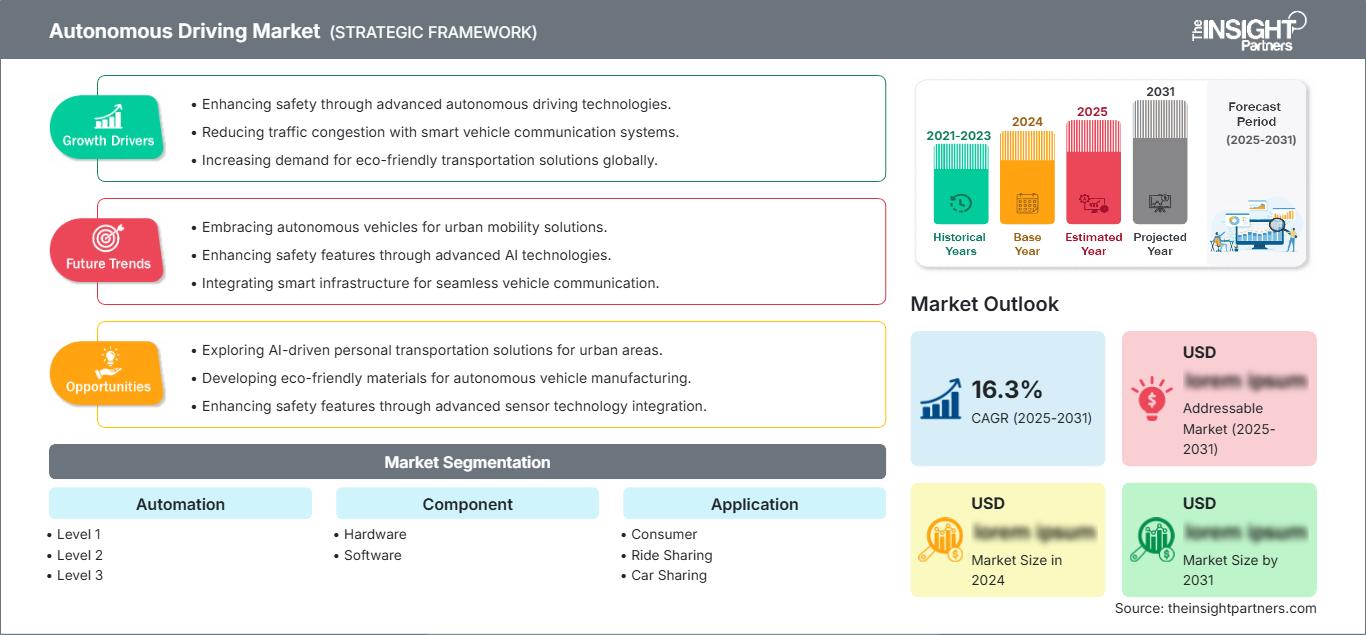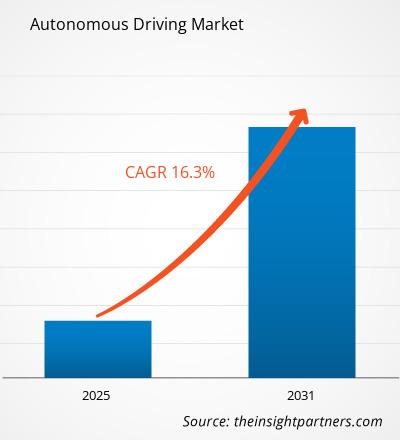자율주행 시장 규모는 2031년까지 4,192억 7천만 달러에 이를 것으로 예상됩니다. 2025년부터 2031년까지 연평균 성장률(CAGR)은 18.5%에 이를 것으로 예상됩니다.
본 보고서는 자동화 수준(레벨 1, 레벨 2, 레벨 3, 레벨 4, 레벨 5), 구성 요소(하드웨어, 소프트웨어), 애플리케이션(소비자, 승차 공유, 차량 공유, 대중교통)별로 세분화됩니다. 전 세계 분석은 지역 및 주요 국가별로 더욱 세분화됩니다. 본 보고서는 위 분석 및 세그먼트에 대한 가치를 미국 달러로 제공합니다.
보고서의 목적
인사이트 파트너스(The Insight Partners)의 자율주행 시장 보고서는 현재 상황과 미래 성장, 주요 성장 요인, 과제 및 기회를 설명하는 것을 목표로 합니다. 이를 통해 다음과 같은 다양한 비즈니스 이해 관계자에게 통찰력을 제공합니다.
- 기술 제공업체/제조업체: 변화하는 시장 역학을 이해하고 잠재적인 성장 기회를 파악하여 정보에 입각한 전략적 결정을 내릴 수 있습니다.
- 투자자: 시장 성장률, 시장 재무 예측 및 가치 사슬 전반에 존재하는 기회에 대한 포괄적인 추세 분석을 수행합니다.
- 규제 기관: 시장의 정책 및 경찰 활동을 규제하여 남용을 최소화하고 투자자의 신뢰와 확신을 유지하며 시장의 무결성과 안정성을 옹호합니다.
자율주행 시장 세분화 자동화
- 레벨 1
- 레벨 2
- 레벨 3
- 레벨 4
- 레벨 5
구성요소
- 하드웨어
- 소프트웨어
애플리케이션
- 소비자
- 라이드 공유
- 카 공유
- 대중교통
지리
- 북미
- 유럽
- 아시아 태평양
- 남미 및 중미
- 중동 및 아프리카
이 보고서의 일부, 국가 수준 분석, Excel 데이터 팩을 포함하여 모든 보고서에 대한 사용자 정의를 무료로 받을 수 있을 뿐만 아니라 스타트업 및 대학을 위한 훌륭한 제안 및 할인을 이용할 수 있습니다
자율주행 시장: 전략적 통찰력

-
이 보고서의 주요 주요 시장 동향을 확인하세요.이 무료 샘플에는 시장 동향부터 추정 및 예측에 이르기까지 데이터 분석이 포함됩니다.
자율주행 시장 성장 동력
- 센서 및 AI 기술의 발전: LiDAR, 레이더, 고급 카메라 시스템과 같은 센서 기술의 급속한 발전과 획기적인 AI 및 머신러닝 알고리즘의 결합은 자율주행차의 인식 및 의사 결정 능력을 획기적으로 향상시키고 있습니다. 딥러닝 신경망은 이제 차량이 복잡한 환경 데이터를 밀리초 단위로 처리하고, 전례 없는 정확성과 신뢰성으로 역동적인 도로 상황을 인식하고 대응할 수 있도록 지원하여 완전 자율주행의 현실화를 앞당기고 있습니다.
- 안전 및 사고 감소 잠재력: 자율주행차는 현재 도로 사고의 90% 이상을 차지하는 인적 오류로 인한 교통사고를 크게 줄일 수 있습니다. 첨단 운전자 보조 시스템(ADAS)과 완전 자율주행 기술은 지속적인 센서 모니터링, 빠른 반응 시간, 피로, 주의 산만, 운전 부주의와 같은 인간의 한계를 제거하여 소비자, 보험사, 규제 기관의 공감을 얻는 설득력 있는 안전 논거를 제시합니다.
- 경제적 효율성 및 비용 최적화: 자율주행 생태계는 인건비 절감, 차량 관리 개선, 연비 향상을 통해 상당한 경제적 이점을 제공합니다. 운송 및 물류 기업은 경로를 최적화하고, 공회전 시간을 최소화하며, 일관된 성능으로 운행하는 자율주행 차량을 도입하여 운영 비용을 획기적으로 절감할 수 있습니다. 24시간 연중무휴 운영 및 유지보수 비용 절감의 잠재력은 자율주행 기술을 점점 더 매력적인 투자로 만들고 있습니다.
자율주행 시장 미래 동향
- 협력 생태계 및 플랫폼 통합: 자율주행 시장은 자동차 제조업체, 기술 기업, 소프트웨어 개발자 간의 전례 없는 협력을 목격하고 있습니다. 자원을 모으고, 기술 전문 지식을 공유하며, 포괄적인 자율주행 플랫폼을 구축하기 위한 전략적 파트너십이 부상하고 있습니다. 이러한 추세는 혁신을 가속화하고, 개별 개발 비용을 절감하며, 공유된 기술 표준 및 상호 운용 가능한 시스템을 통해 시장 진입 속도를 높이고 있습니다.
- 규제 프레임워크 진화: 글로벌 규제 환경은 자율주행차 기술을 수용하기 위해 점진적으로 적응하고 있으며, 혁신과 공공 안전의 균형을 이루는 포괄적인 프레임워크를 개발하고 있습니다. 정부는 전문 시험 구역을 조성하고, 교통법을 개정하며, 자율주행차 도입에 대한 명확한 지침을 수립하고 있습니다. 이처럼 변화하는 규제 환경은 자율주행 기술에 대한 상업적 구현과 투자자 신뢰를 위한 더욱 명확한 경로를 제공하고 있습니다.
자율주행 시장 기회
- 도시 모빌리티 및 서비스형 교통: 자율주행차는 특히 공유 자율주행차(SAV) 모델을 통해 도시 모빌리티에 혁신적인 기회를 제공합니다. 밀집된 도시 환경에서 자율주행 기술을 활용하여 교통 체증을 줄이고, 탄소 배출량을 줄이며, 노인과 장애인을 포함한 다양한 계층에게 접근 가능한 모빌리티 솔루션을 제공하는 효율적인 온디맨드 교통 네트워크를 구축할 수 있습니다.
- 데이터 수익화 및 생태계 서비스: 자율주행 혁명은 전례 없는 규모의 실시간 데이터를 생성하여 데이터 수익화 및 부가가치 서비스에 대한 수익성 있는 기회를 창출합니다. 자율주행차는 운송수단을 넘어 모바일 데이터 수집 플랫폼으로 활용될 수 있으며, 도시 계획, 보험 모델, 예측 유지관리, 개인화된 사용자 경험에 대한 통찰력을 제공하여 기존 운송 패러다임을 넘어 수익원을 확대할 수 있습니다.
자율주행 시장
The Insight Partners의 분석가들은 예측 기간 동안 자율주행 시장에 영향을 미치는 지역별 동향과 요인을 면밀히 분석했습니다. 이 섹션에서는 북미, 유럽, 아시아 태평양, 중동 및 아프리카, 그리고 중남미 지역의 심장 리듬 질환 관리 시장 부문과 지역별 현황도 살펴봅니다.
자율주행 시장 보고서 범위
| 보고서 속성 | 세부 |
|---|---|
| 시장 규모 2024 | US$ XX Billion |
| 시장규모별 2031 | US$ 419.27 Billion |
| 글로벌 CAGR (2025 - 2031) | 18.5% |
| 이전 데이터 | 2021-2023 |
| 예측 기간 | 2025-2031 |
| 다루는 세그먼트 |
By 자동화
|
| 포함된 지역 및 국가 |
북미
|
| 시장 선도 기업 및 주요 회사 프로필 |
|
자율주행 시장 참여자 밀도: 비즈니스 역학에 미치는 영향 이해
자율주행 시장은 소비자 선호도 변화, 기술 발전, 그리고 제품 이점에 대한 인식 제고 등의 요인으로 인한 최종 사용자 수요 증가에 힘입어 빠르게 성장하고 있습니다. 수요가 증가함에 따라 기업들은 제품 및 서비스 확장, 소비자 니즈 충족을 위한 혁신, 그리고 새로운 트렌드를 적극 활용하며 시장 성장을 더욱 가속화하고 있습니다.

- 을 얻으세요 자율주행 시장 주요 주요 플레이어 개요
주요 판매 포인트
- 포괄적인 범위: 본 보고서는 자율주행 시장의 제품, 서비스, 유형 및 최종 사용자에 대한 분석을 포괄적으로 다루어 전체적인 전망을 제공합니다.
- 전문가 분석: 본 보고서는 업계 전문가 및 분석가의 심층적인 이해를 바탕으로 작성되었습니다.
- 최신 정보: 본 보고서는 최신 정보 및 데이터 동향을 포괄하여 비즈니스 관련성을 보장합니다.
- 맞춤 설정 옵션: 본 보고서는 특정 고객 요구 사항과 비즈니스 전략에 맞춰 맞춤 설정할 수 있습니다.
따라서 자율주행 시장 연구 보고서는 업계 상황과 성장 전망을 해석하고 이해하는 데 도움이 될 수 있습니다. 몇 가지 타당한 우려 사항이 있을 수 있지만, 본 보고서의 전반적인 이점은 단점보다 훨씬 큰 경향이 있습니다.
- 과거 분석(2년), 기준 연도, CAGR을 포함한 예측(7년)
- PEST 및 SWOT 분석
- 시장 규모 가치/거래량 - 글로벌, 지역, 국가
- 산업 및 경쟁 환경
- Excel 데이터세트
최근 보고서
사용 후기
구매 이유
- 정보에 기반한 의사 결정
- 시장 역학 이해
- 경쟁 분석
- 고객 인사이트
- 시장 예측
- 위험 완화
- 전략 기획
- 투자 타당성 분석
- 신흥 시장 파악
- 마케팅 전략 강화
- 운영 효율성 향상
- 규제 동향에 발맞춰 대응






















 무료 샘플 받기 - 자율주행 시장
무료 샘플 받기 - 자율주행 시장